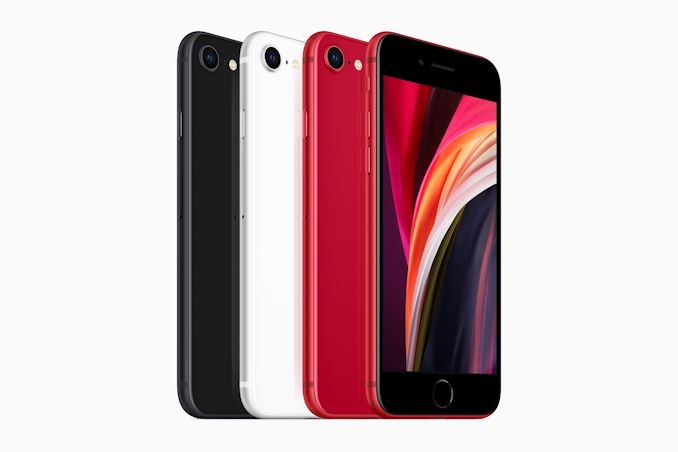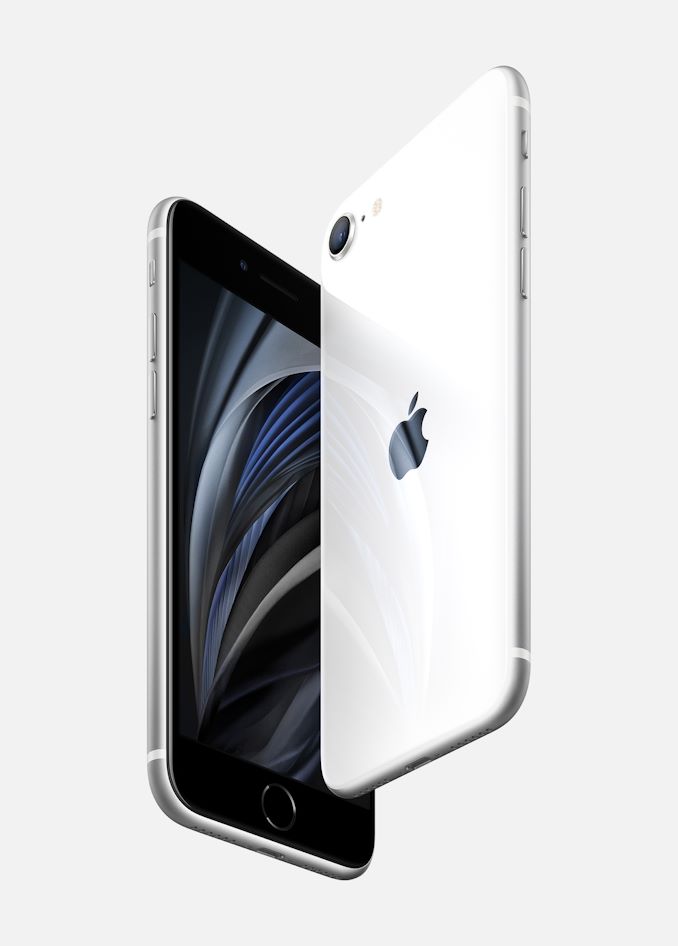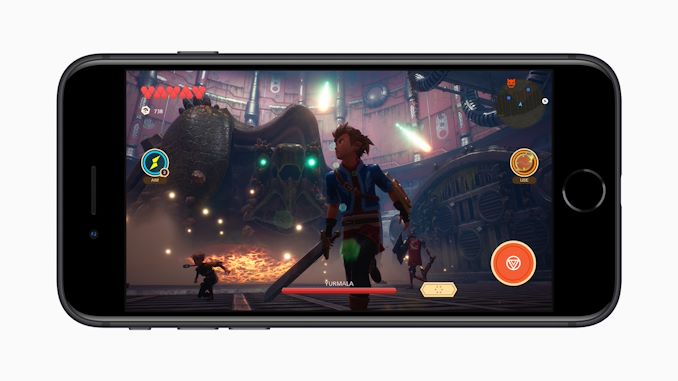Apple Announces New Updated iPhone SE: A13 & New Features for $399
by Andrei Frumusanu on April 15, 2020 1:00 PM EST- Posted in
- Mobile
- Apple
- Smartphones
- iPhone SE 2020

Apple’s last “classic” iPhone release was the iPhone 8 back in 2017, with the 2016 iPhone SE (Special Edition) being the last iteration donning the iPhone 4 design language. It’s safe to say both these devices had been getting a bit long in the tooth, and there’s still plenty of people out there which loved the 4.7” form-factor – and possibly unwilling to update to the newer bigger models.
Luckily, Apple seemingly agrees that this market is worth covering, and today announced a refresh of the 2016 iPhone SE. The new 2020 special edition model takes its design cues from the iPhone 8, essentially taking it as a blueprint for the shell of the phone, and crams in the latest hardware technology that were premiered with the iPhone 11 series.
Most importantly, Apple is offering this new small fierce package at an incredible price point starting at $399, significantly cheaper than even the “lower-end” iPhone 11. The combination seems an outright winner, let’s go over the specifications:
| Apple 2019-2020 iPhone Specifications | |||||
| iPhone 11 Pro | iPhone 11 Pro Max | iPhone 11 |
iPhone SE
|
||
| SoC | Apple A13 Bionic 2 × Lightning Performance @ 2.66GHz 8MB L2 4 × Thunder Efficiency @ 1.73GHz 4MB L2 |
||||
| GPU | Apple, 4 Cores | ||||
| DRAM | 4GB LPDDR4X | ?? | |||
| Display | 5.8-inch OLED 2436×1125 DCI-P3/True Tone 800 cd/m² brightness 2M:1 contrast ratio |
6.5-inch OLED 2688×1242 DCI-P3/True Tone 800 cd/m² brightness 2M:1 contrast ratio |
6.1-inch LCD 1792×828 DCI-P3/True Tone 625 cd/m² brightness 1400:1 contrast ratio - |
4.7-inch LCD 1334×750 DCI-P3/True Tone 625 cd/m² brightness 1400:1 contrast ratio - |
|
| Size | Height | 144.0 mm | 158.0 mm | 150.9 mm | 138.4 mm |
| Width | 71.4 m | 77.8 mm | 75.7 mm | 67.3 mm | |
| Depth | 8.1 mm | 8.1 mm | 8.3 mm | 7.3 mm | |
| Weight | 188 grams | 226 grams | 194 grams | 148 grams | |
| Battery Life | 3046mAh +14.5% capacity "+4H vs XS" |
3969mAh +25% capacity "+5H vs XS Max" |
3110mAh +5.7% capacity "+1H vs XR" |
?? | |
| Wireless Charging | Qi | ||||
| Rear Cameras | Main | 12 MP 1.4µm Dual Pixel PD f/1.8, OIS Wide Color Gamut Quad LED True Tone Flash |
12 MP 1.4µm f/1.8, OIS Wide Color Gamut Quad LED True Tone Flash |
||
| Tele- Photo |
12 MP f/2.0 Telephoto, OIS 2x Optical Zoom |
- | - | ||
| Wide | 12MP f/2.4 120° Ultra-wide Angle |
- | |||
| Front Camera | 12MP f/2.2 Wide Angle | 7MP f/2.2 | |||
| Storage | 64 GB 256 GB 512 GB |
64 GB 256 GB 512 GB |
64 GB 128 GB 256 GB |
64 GB 128 GB 256 GB |
|
| I/O | Apple Lightning | ||||
| Wireless (local) | 802.11ax Wi-Fi with MIMO + Bluetooth 5.0 + NFC | ||||
| Cellular | Gigabit-class LTE-A 4x4 MIMO and LAA |
Gigabit-class LTE-A 2x2 MIMO and LAA |
Gigabit-class LTE-A |
||
| Splash, Water, Dust Resistance | IP68 up to 2 meters (Pro models = 4 meters), up to 30 minutes |
IP67 up to 1 meters, up to 30 minutes |
|||
| Dual-SIM | nano-SIM + eSIM | ||||
| Launch Price | 64 GB: $999 / £1049 / 1149€ 256 GB: $1149 / £1199 / 1319€ 512 GB: $1349 / £1399 / 1549€ |
64 GB: $1099 / £1149 / 1249€ 256 GB: $1249 / £1299 / 1419€ 512 GB: $1449 / £1499 / 1649€ |
64 GB: $699 / £729 / 799€ 128 GB: $749 / £779 / 849€ 256 GB: $849 / £879 / 969€ |
64 GB: $399 / £419 / €479 128 GB: $449 / £469 / €529 256 GB: $549 / £569 / €649 |
|
In terms of hardware, the new 2020 iPhone SE is powered by Apple’s latest A13 chip. Currently this is the most powerful and power efficient mobile chip on the market, and Apple integrating this into the new generation SE probably results in the phone packing quite a punch for its size.
Connectivity wise, it’s also on par with the iPhone 11, featuring “gigabit-class” LTE-A cellular as well as the newest WiFi 6 chipsets for better reception on crowded compatible networks.
We currently don’t have information on the DRAM configuration of the phone, but hopefully Apple doesn’t differ it too wildly from the 4GB standard setup on the iPhone 11 models.
Design-wise, the new iPhone SE should be a very familiar sight to users as it adopts the iPhone 8 design language and frame. This includes a 4.7” 1334 x 750 resolution LCD panel – which in likelihood will be the same as that found on the iPhone 8.
The form-factor nowadays would seem outright diminutive as the phone is smaller in every dimension, coming in at only 138.4 x 67.3 x 7.3mm and weighing in only 148g. If you’ve been looking to get a smaller phone and are in the iPhone ecosystem, the new iPhone SE is the device to get.
On the camera side, the SE only has a single camera – a 12MP sensor with f/1.8 optics and OIS. This isn’t the newer generation sensor found on the iPhone 11 series as it lacks the full-sensor dual-pixel phase detection capability, so it’s likely the unit from the previous XS or iPhone 8 generation. However this doesn’t mean that picture quality will be any less, as Apple promises the phone to perform as the “best single-camera system ever in an iPhone”, and the A13’s new ISP and image processing algorithms will certainly augment the camera to be extremely competitive with what we’ve seen in the iPhone 11 series.
As the phone still features a physical home button, the preferred method of unlocking is Touch ID as the phone lacks the relevant Face ID sensor hardware. Again, iPhone users will be extremely familiar with the setup here as it’ll be essentially the same as what’s found on an iPhone 8.
A Product That Speaks For Itself - Starting At $399
All in all, the iPhone SE is a product that essentially speaks for itself. It’ll be fulfilling the nostalgia needs of users who had been apprehensive to move onto Apple’s newer “iPhone X” design iteration of phones, all whilst updating the internal hardware of the phone in order to not be left out of the generational technology improvements seen by the newest silicon.
It also represents amongst the smallest phones on the market right now – you’d have a very hard time finding similar form-factor smartphones, let alone iPhones.
Apple’s aggressive pricing of starting at $399 for the 64GB base model is going to make this phone a runaway success, even undercutting the iPhone 8 that had been selling for $449 until now (and has now been discontinued). Even the higher storage variants at 128 and 256GB seem outright reasonable at $449 and $549, undercutting the iPhone 11 by $300. European prices start at £419 in the UK and 479€ in continental Europe – a 10% premium on top of the usual VAT margin, so not quite as an aggressive pricing scheme as in the US.
Pre-orders start this Friday, April 17th, with in-store availability next Friday, April 24th.













109 Comments
View All Comments
OMGitsShan - Wednesday, April 15, 2020 - link
Was hoping this would be the smaller iPhone 5 size with edge to edge screen but with newer internals. Sometimes a smaller phone is much more handy.krazyfrog - Wednesday, April 15, 2020 - link
That is no longer a realistic wish. The iPhone 5 body will be incapable of managing the power and thermal requirements of a 2020 flagship chipset.close - Wednesday, April 15, 2020 - link
It could with a lot more aggressive throttling or a dedicated chip. None of which Apple would reasonably want to do.On the other hand I never thought the day will come when AT's front page had 2 reviews for OP's $1000 phone and Apple's $400 phone... The SE is a flagship killer I guess. Will probably replace my OP5 eventually.
ads295 - Wednesday, April 15, 2020 - link
Given the paltry resolution of the display and the sheer power of the chipset, I don't think such power and thermal headroom is necessary.close - Wednesday, April 15, 2020 - link
Rendering pixels is not the only thing the SoC is expected to do. There's also the CPU side. And if you run into that kind of workload that stresses any other part of the SoC there's not much room for dissipating the heat without also making it uncomfortable or even dangerous (heating up the battery). So at best they'd really throttle it a lot wasting much of that horsepower. And building a dedicated SoC makes little sense for this kind of phone.quiksilvr - Wednesday, April 15, 2020 - link
The biggest battery drainer is and always will be the screen. The GPU is rendering at barely over 720p and its only 4.7". This thing will have insane battery life.iphonebestgamephone - Thursday, April 16, 2020 - link
Is it still the screen when you are running something that uses 100% cpu?close - Thursday, April 16, 2020 - link
We were talking about "power and thermal headroom" (quote) *in an iPhone 5 sized phone*, not the screen. The screen may be a big power draw (although not so much in a 4", lowish res version) but it's nothing to what a SoC draws at full power and the heat the SoC puts out. Having a high performance SoC like the A13 working at full power with very little room or metal to dissipate the heat is certainly bad. Which means either the SoC will spend most of its time throttled or it will cook everything around it, battery and hands included.Hence an iPhone5 sized chassis doesn't make sense unless you pair it with a lower end SoC, something I'm sure Apple doesn't want.
BedfordTim - Thursday, April 16, 2020 - link
Unless something has gone horribly wrong the SoC will be massive overkill for all but the most extreme gaming. Even a cheapo Mediatec Soc can handle web browsing, email and normal gaming perfectly adequately, and iPhone apps should run perfectly adequately on older iPhones with less efficient SoCs.ads295 - Thursday, April 16, 2020 - link
Apple will most likely underclock this SoC in this application.The battery size is the same as the iPhone 8 at 1821mAh, so...